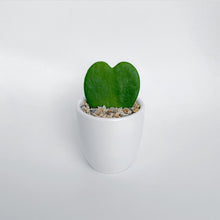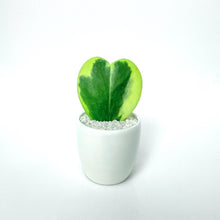Potted in white ceramic pot with drain hole. Pot style may vary from photo and approximate size of pot may be 2.75-3" in diameter and 2-3" in height.
Hoya kerrii is a slow-growing, low-maintenance indoor plant. With its distinctive heart-shaped single leaf, it is one of the most sought-after houseplants and takes some years to grow into vining plants. Once the plant establishes a healthy root system though, the vines and new leaves start forming quickly. However, if your plant has only a single leaf without a stem, it might stay like this and not vine.
Care Guide:
Hoyas need plenty of light to grow properly. Sunny windows with indirect light are perfect. For optimal results, position inside your office or house as bright, indirect sunlight is best.
Like other succulent plants, Hoyas can store water for a long time between waterings so the watering needs of this plant are low. Make sure to let the soil dry out before watering again. The soil should not be watery or saturated, as this will cause rotting. Be cautious if the pot doesn’t have any drainage holes.
Hoya doesn’t need much feeding, especially if it only has a single leaf. Fertilize twice a year to aid the growth.
Hoya prefers a well-draining, neutral, and mildly acidic soil mix. Over time, soil mix starts breaking down and loses its moisture-holding abilities. As a result, the roots will start rotting. Repot Hoyas every two years to avoid this problem.
The propagation of this plant is done with stem and single-leaf cuttings. Be patient as new growth is slow. The plant won’t grow any bigger when using the leaf-cutting method, but will still root. Make sure to include some stem when taking the cuttings. The stem cutting method creates aerial roots more quickly if you plant them in a moist medium. Be sure to let the cuttings dry for at least a day before you plant.
Hoya plants are generally pest and disease-free. Be on the lookout for mealybugs though. They usually attack both the root and stem. If left untreated, it leads to a fungal disease. Make sure to remove any dying or dead stem before the other stems get infected too. Over-watering and prolonged humid conditions often lead to rotting of leaves.
If you witness the leaves of the plants shriveling, then it is a sign of under-watering. However, if you have been watering this plant properly, there might be root rot. Check for signs and treat them immediately.




